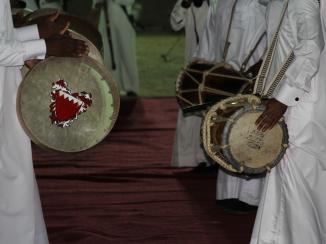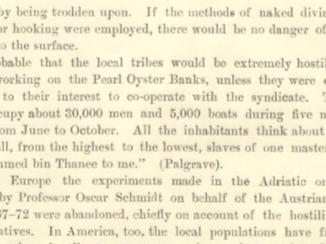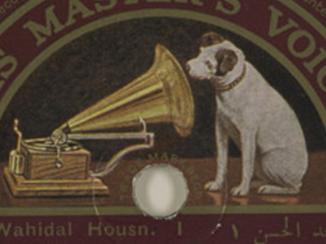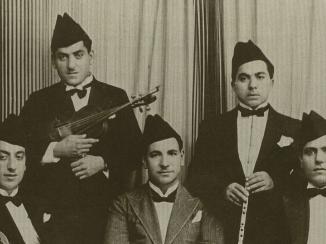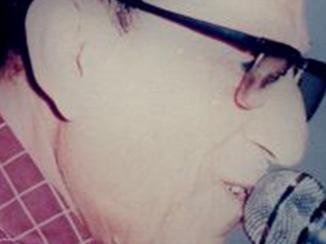Overview
“The music began … a large Arab … who played a guitar … he was a famous singer from Kuwait … his name was Ismael … now and again, sailors rose to their feet and danced in couples, shuffling along the carpet side by side … ”
In 1939, the explorer, photographer and writer The lowest of the four classes into which East India Company civil servants were divided. A Writer’s duties originally consisted mostly of copying documents and book-keeping. Alan Villier vividly described a celebratory event on a Kuwaiti trading boat in the middle of the Arabian Gulf. He claimed that he did not like the Gulf’s music, but he could describe it so accurately that we are able to identify the genre. In this case, he writes about ṣawt music, a singer accompanying himself on the oud string instrument and the sailors performing the corresponding zifān dance.
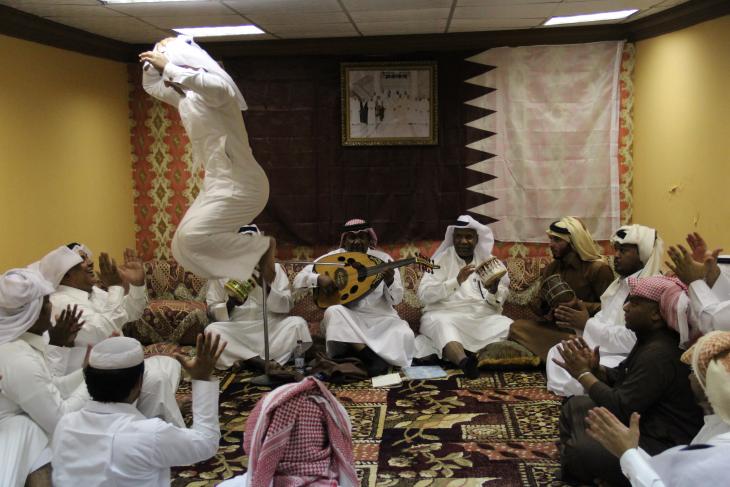
This article provides an overview of the most common musical instruments prevalent in the Gulf region; it corresponds to the article about musical genres.
Origin and Use of Musical Instruments
Like in other Arabic musical genres in the Gulf region, the voice is the primary and most important instrument. This is related to the fact that poetry has been a part of everyday life for the Arab people living on land and the coast and travelling on ships in the Gulf. In addition, these people created the trademark of intricate interlocking patterns expressed through hand-clapping (taṣfīq), finger-clicking and drumming on everyday articles (such as pots and metal objects). The Indian musicologist BC Deva describes this as the "non-musical beginnings of instruments”.
Up to this day, the voice, handclapping and the use of percussion instruments are essential to the music of the Gulf. Therefore, it is no surprise that drums and idiophones far outnumber string and wind instruments. Lisa Urkevich states that even the triangular lyre ṭanbūra is “basically a rhythm instrument, not a melodic one”.
Many melodic instruments, such as the Western violin, the ṣurnāy (oboe type) or the rebāba, either imitate, follow or interact with the voice. The way the string instrument oud is played in the Gulf reminds one of the strong rhythmic patterns of the music.
As in other musical regions, musical instruments have always travelled and were incorporated into their own music.
Regional folklore tells us that different sized frame drums, such as the ṭār, and the one-stringed chordophone rebāba were first created in the desert of Saudi Arabia (see, for instance, Lisa Urkevich).
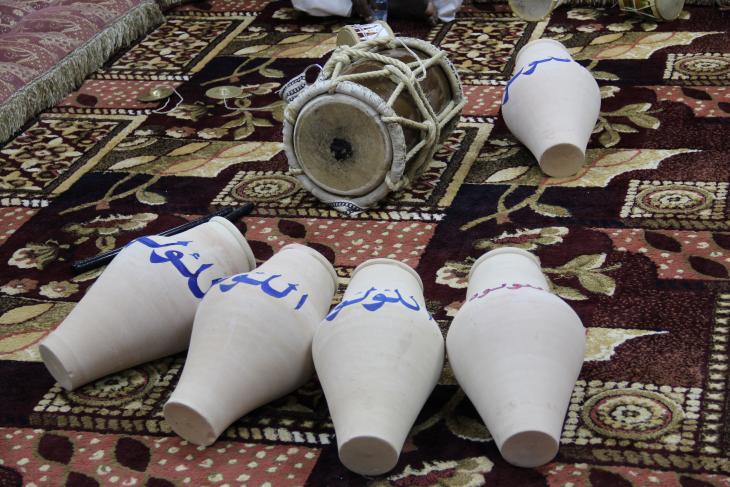
The cylindrical baḥri ṭabl is still called ‘Indian drum’ today; indeed the playing mode and form is similar to a group of drums in northern India called dhol. While the jaḥla or Aleihlh clay ‘drum’ has a clear non-musical origin – it is a pot to keep water – it reminds one of the gatham pot drum played in Karnatic music in south India. The playing mode and rhythms of the ‘typically’ Gulf small double-headed drum mirwās is similar to the udukku drum in Kerala (south-west Indian state).
The Gulf musicians who perform genres with strong roots from Africa, for instance laywa and ṭanbūra, trace their instruments to ‘Africa’ (more specifically, present-day Tanzania, Kenya, Sudan and Upper Egypt). Most important are the triangular lyre ṭanbūra and the drums used in laywa music, ṭabl al ‘oad, musūndū, and chechānga. The instruments, like the genres, often have a dual function; to perform music and to serve in ritualistic activities.
Grouping of Musical Instruments – The Sachs-Hornbostel System
To categorise and describe the Gulf musical instruments, this article broadly follows the system developed in 1914 by the German organologists Erich von Hornbostel and Curt Sachs (subsequently called 'H-S system'; see overview below).
Hornbostel and Sachs based their categories entirely on the method of sound production, using three subcategories (these are sub-classes, orders, and sub-orders), and the Dewey Decimal Classification System. They classified musical instruments into idiophones, membranophones, aerophones, and chordophones. Idiophones are instruments “whose material is sufficiently rigid and at the same time sufficiently elastic to undergo periodic vibration”. Membranophones are those “on which sound waves are excited through the agency An office of the East India Company and, later, of the British Raj, headed by an agent. of tightly stretched membranes”, and aerophones are those in which “columns of air vibrate”. Chordophones are instruments on which “one or more strings are stretched between fixed points” and “in which strings vibrate” (Hornbostel, Sachs).
In the Gulf, there exists a strong relationship between a specific genre and the corresponding musical instruments. Therefore, there is a high probability that if a genre is performed, the instruments are also there. This means that if the subsistence of traditional musicians and the active performance of genres is maintained, the skill of instrument playing in the Gulf will also be continued.
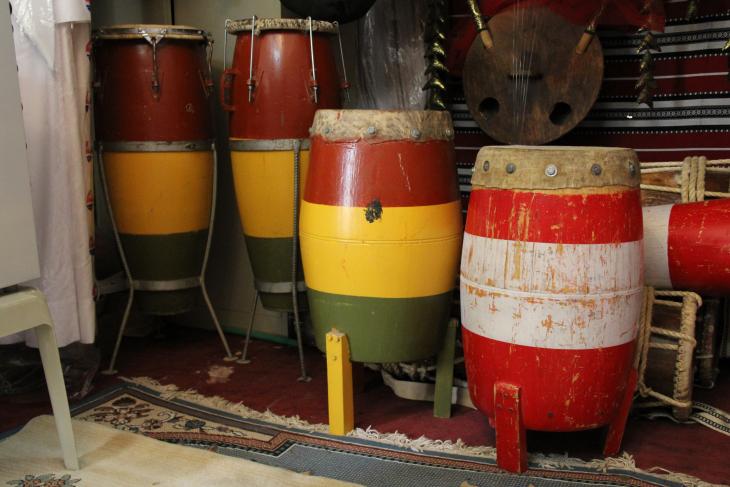
Musical Instrument Classification Following the 'H-S System'
| Type of Instrument | Description | Genre |
| Idiophones | ||
| jaḥala | A clay water jug percussion instrument | baḥri |
| manjūr | Rattle: sheep/goat hooves fixed to a cotton cloth The dancer wears the cloth like a belt. |
ṭanbūra |
| bātū | A small crushed metal container played with two bamboo sticks | laywa |
| jigange | Assembled different sounding metal plates played with two bamboo sticks | laywa |
| tus or ṭuwaysa | Small cymbals | baḥri |
| Membranophones | ||
| ṭār (pl. ṭīrān) | Different sized frame drums with jingle bells attached to the inner rim | baḥri, al ‘arḍa |
| ṭabl baḥri | A large double-headed cylindrical drum played with drumstick (right) and bare left hand | baḥri, al ‘arḍa |
| mirwās | A small double-headed drum played with finger/hand | baḥri, ṣawt |
| ṭabl Nubia – the Nubian drum | A double-headed cylindrical drum played with drumstick (right) and bare left hand The player sits and the drum rests on the ground. |
ṭanbūra |
| ṭabl al ‘oad | A single headed barrel drum played with two thick sticks (played standing up with the drum tilted towards the player) | laywa |
| musūndū | A single headed barrel drum played with hands (played fixed to waist and resting on floor) | laywa |
| chechānga | A single headed barrel drum played with hands (held with shoulder strap); smaller than musūndū | laywa |
| Aerophones | ||
| ṣurnāy | A double-reed wind instrument with a bell | laywa |
| habbān (also called jirba) | A bagpipe with reed and air reservoir (the bag) made of animal hide | habbān |
| Chordophones | ||
| ṭanbūra | A triangular lyre with pentatonic tuning | ṭanbūra |
| oud | A pear-shaped short-necked lute | ṣawt |
| violin | A four-stringed Western violin | ṣawt |
| rebāba | A one-string spike fiddle, traditionally used to accompany poetry The quadrilateral sound box is covered with skin and played with a horsehair bow. |
rebāba |
Listen to:
Playlist Kuwait:
Playlist Bahrain:

